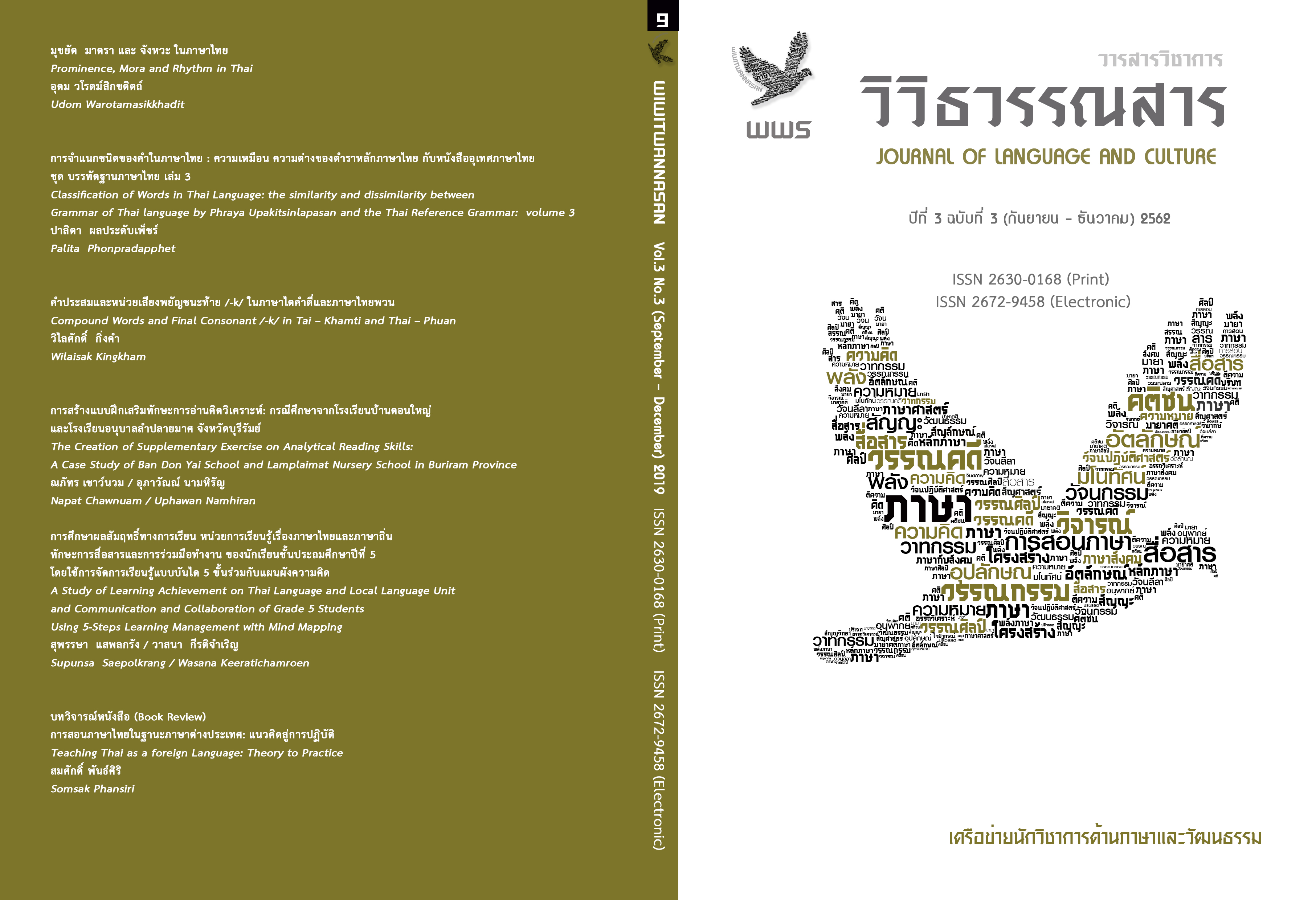คำประสมและหน่วยเสียงพยัญชนะท้ายในภาษาไตคำตี่และภาษาไทยพวน
Main Article Content
บทคัดย่อ
การสร้างคำประสมในภาษาไตคำตี่และภาษาไทยพวน ประกอบด้วยคำมูลที่เป็นคำนามตามด้วยคำนาม คำนามตามด้วยคำกิริยาทั้งสองภาษามีการสร้างคำที่ใช้คำนามประกอบด้วยคำนามมากที่สุด และพบอีกประการหนึ่งที่สำคัญคือ ไม่พบการสร้างคำในภาษาไตคำตี่ และภาษาไทยพวน ที่นำคำอุปสรรค คำปัจจัย และคำอาคม มาประกอบคำ ยกเว้นภาษาไทยพวน มีคำยืมจากภาษามาตรฐาน
Article Details
รูปแบบการอ้างอิง
Kingkham, W. (2019). คำประสมและหน่วยเสียงพยัญชนะท้ายในภาษาไตคำตี่และภาษาไทยพวน. Journal of Variety in Language and Literature, 3(3), 63–80. สืบค้น จาก https://so06.tci-thaijo.org/index.php/wiwitwannasan/article/view/215683
ประเภทบทความ
บทความวิชาการ/บทความวิจัย
ลิขสิทธิ์ของบทความเป็นของวารสาร การพิมพ์ซ้ำจะต้องได้ร้บการอนุญาตจากบรรณาธิการวารสาร
เอกสารอ้างอิง
Carl, J. (1989). Contrastive Analysis. London: Longman.
Chulalongkorn University. (1976). Tai Linguistics In Honor of Fang Kuei Li. Bangkok: Chulalongkorn University Press.
Dhogde, R.V. and Willisak Kingkham. (1992). “A Comparison of Phonology and Morphology in Standard-Thai and Tai-Phake.” In PAN-ASIATICLINGUISTICS the third International Symposium on Language and Linguistics. Bangkok: Chulalongkorn University Press.
Gedney, W.J. (1972). “A checklist for Determining Tones in Tai Dialects” in M. Estelle Smith (ed). Studies in Linguistics in honor of George L. Trager (pp.423-37). The Hague: Mouton.
Goswami, S.N. (1998). Studies in Sino-Tibetan Language. Gauhati Assam: Arunoday Press.
Haas, M. R. (1942). The Use of Numeral Classifiers in Thai Vol.18, No.3 Language XVIII, (pp.201-205). New York: New York Press.
Hockett,C.F. (1958). A Course in Modern Linguistics. New York: The memillan.
Katz, J. J. (1972). Semantic Theory. Marper International Edition. New York: Haper and Row, Publishers.
Li, F.K. (1977). A handbook of comparative Tai. Honolulu: University of Hawaii.
Nida, E. A. (1967). Mophology-the descriptive analysis of words. 2 nd ed, Ann Arbor: University of Michigan Press.
Ruangdej, P. (1976). “A synchronic – comparative study of Modern Thai and Modern Lanna.” Ph.D. Thesis, University of Poona, India.
Ruangdej, P. (1978). Yong Phonology Southeast Asia. Nakorn Pathom: Language Centre, Mahidol University Press.
Samon, G. (1983). “A synchronic – Comparative – Contrastive Study of Modern I-san (Northeastern Thai) and Standard-Thai.” Ph.D. Thesis, University of Poona, India.
Chulalongkorn University. (1976). Tai Linguistics In Honor of Fang Kuei Li. Bangkok: Chulalongkorn University Press.
Dhogde, R.V. and Willisak Kingkham. (1992). “A Comparison of Phonology and Morphology in Standard-Thai and Tai-Phake.” In PAN-ASIATICLINGUISTICS the third International Symposium on Language and Linguistics. Bangkok: Chulalongkorn University Press.
Gedney, W.J. (1972). “A checklist for Determining Tones in Tai Dialects” in M. Estelle Smith (ed). Studies in Linguistics in honor of George L. Trager (pp.423-37). The Hague: Mouton.
Goswami, S.N. (1998). Studies in Sino-Tibetan Language. Gauhati Assam: Arunoday Press.
Haas, M. R. (1942). The Use of Numeral Classifiers in Thai Vol.18, No.3 Language XVIII, (pp.201-205). New York: New York Press.
Hockett,C.F. (1958). A Course in Modern Linguistics. New York: The memillan.
Katz, J. J. (1972). Semantic Theory. Marper International Edition. New York: Haper and Row, Publishers.
Li, F.K. (1977). A handbook of comparative Tai. Honolulu: University of Hawaii.
Nida, E. A. (1967). Mophology-the descriptive analysis of words. 2 nd ed, Ann Arbor: University of Michigan Press.
Ruangdej, P. (1976). “A synchronic – comparative study of Modern Thai and Modern Lanna.” Ph.D. Thesis, University of Poona, India.
Ruangdej, P. (1978). Yong Phonology Southeast Asia. Nakorn Pathom: Language Centre, Mahidol University Press.
Samon, G. (1983). “A synchronic – Comparative – Contrastive Study of Modern I-san (Northeastern Thai) and Standard-Thai.” Ph.D. Thesis, University of Poona, India.


